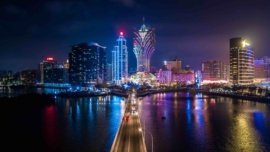There are not a few who would swear under oath that there is no architecture worth its name in COTAI.
This is evidently a radical view of architecture. The Assistant Professor of the Faculty of Creative Industries at the University of St. Joseph, Francisco Vizeu Pinheiro put things in other terms, when interviewed by Macau Business: “There is no Macau architecture in COTAI, and unlike Las Vegas, we do not even have an urbanism and landscaping that connects this patchwork. In Las Vegas, the pedestrian areas are pleasant – lots of open areas, shows, animations, good public transport. In Macau, each slot, each casino-box group is separated from the others.”
Vizeu Pinheiro is a Portuguese architect and this reality weighs on his evaluation. He and other experts, of Portuguese descent, criticise the importation of models of Las Vegas, misfits to the reality of Macau.
 Rita Serra e Silva, who presented a master thesis on Macau casinos in Portugal, offers a very concrete example: “The image of Wynn Macau is a reinterpretation of the design used in Wynn Las Vegas. A prototype building that adapts or, better, that imposes itself upon any context without considering the culture of the place. It consists of a copy-paste process that is translated into the propagation of a slightly modified object whose image allows a quick identification of the creator.”
Rita Serra e Silva, who presented a master thesis on Macau casinos in Portugal, offers a very concrete example: “The image of Wynn Macau is a reinterpretation of the design used in Wynn Las Vegas. A prototype building that adapts or, better, that imposes itself upon any context without considering the culture of the place. It consists of a copy-paste process that is translated into the propagation of a slightly modified object whose image allows a quick identification of the creator.”
The thesis advisor of Mrs. Serra e Silva, Jorge Figueira, is even more unequivocal: “The success of Sands Macau, built in the NAPE area in 2004 by Paul Steelman Design Group Asia, opened an era in which the architecture of casinos not only on the scale of contracting but also in the global organisation of the projects, calls into question the more local or intimate practices of the offices of the Portuguese tradition.”
The result of this is that “COTAI has thus become a leisure city for tourists and little interested in responding to local needs,” says Vanessa Iglésias, another researcher on the architectural reality of Macau, quoted from a thesis that she produced on the subject. “The COTAI Strip is a clear example of this ‘non-place’, since it is connected to the world of casinos, highly discharged, translating into a road, the Istmo Road, with direct connection to the most representative casinos of COTAI . . . This ‘New Macau’ overlaps with the very identity of the city leading it, progressively, to the loss of its genesis and historical essence.”
It is not only the Portuguese architects who mourn the way the landscape has been shaped in COTAI. The Co-ordinator for the Department of Architecture at the University of Saint Joseph, Thomas Daniell, wrote an essay on the subject, stating, in particular, that “most integrated resorts (or ‘casino complexes’) cover an entire city block, but each has only a couple of public entrances, serviced by fleets of complimentary buses and taxis shuttling between the airport, the ferry terminals, the border crossings to China, and the other casinos.”
With what consequences?
“Disengaged from, if not actively inhibiting, everyday street life, COTAI’s integrated resorts are designed using exotic styles that explicitly and emphatically avoid any relationship with local history or context.”
Hong Kong-based scholar Hendrik Tieben, an expert on the Macau landscape, joins these voices: “The adaptation of the Las Vegas model of space-consuming casino resorts for Macau should, therefore, be questioned. While the COTAI reclamation was used to create an ‘Asian Las Vegas’ due to land scarcity the height of new residential developments in the already overcrowded residential districts has increased from 30 to 56 storeys.”
The most curious thing is that it is not just the architects or university researchers who lament the choices made. Andrew M. Klebanow and Steven M. Gallaway of Global Market Advisors produced a White Paper in 2015 titled ‘Casinos and the City,’ in which they state: “The vast majority of casino development in North American cities and more recently on the COTAI Strip in Macau can best be described as island casino development. This term refers to casinos that are built as self-contained developments, with all non-gaming amenities located within the casino complex.”
The problem, they say, is that “urban casinos developed in the latter part of the 20th Century failed to integrate themselves into their host communities, did not stimulate economic and commercial activity in their host neighbourhoods and essentially became islands within the greater urban landscape.”
Let’s return to the chat with Vizeu Pinheiro, who declares: “Casinos are like factories, factories to make money for some entertainment. Not all factories have to look like crates; some of them are very innovative, as is the case with BMW Welt, north of Munich.”
 The landmark
The landmark
Francisco V. Pinheiro states that in COTAI there’s a “catalogue of buildings, imported or adapted and distributed in a patchwork.”
All of them?
No. Our expert underlines one exception – the Zaza Hadid hotel, known as Morpheus, located in the City of Dreams complex (Melco) and slated to open next year. It will feature 780 rooms, restaurants, an executive lounge, a sky pool and VIP gaming and villas on the top floors in the two towers reachin g 39 floors, connected at both the podium level and the roof.
g 39 floors, connected at both the podium level and the roof.
“There are two reasons for having aseptic buildings [in COTAI]. One is the urban and building regulations, which as in Hong Kong are made to maximise the density of space, to sell as much as possible, resulting in high density crates. The second reason is that we have no famous architect of world rank in Macau.
“For this, it would be easy to solve by inviting architects of that level to design for COTAI but the local guys would probably protest, as happened in the case of Hotel Estoril,” said the Assistant Professor of the Faculty of Creative Industries at the University of St. Joseph and Visiting Professor in Jiangnam University. Mr. Pinheiro’s work involves the urban rehabilitation projects of Macau’s historical centres.
> COTAI 10 incredible years | The effect – Taipa Ferry Terminal
























